You are being watched. Whatever you tweet, whatever you ‘like’ on Facebook, whatever you look at on your smartphone, it’s all being monitored and recorded - and not just by shady government agencies.
Brands and retailers are using all that information to get to know you, perfectly legitimately, in order to sell to you more effectively. For instance, if someone ‘likes’ Coca-Cola on Facebook, Coca-Cola knows that particular person is ripe to be hit with a campaign for a new product or promo. Equally, a retailer such as Tesco knows it can lure that customer into a store if it sends them some half-price vouchers for Coca-Cola.
In numbers
$120: Will buy 10,000 likes for a Facebook page from click farms based in the developing world
95%: Of marketers say they plan to use Facebook as part of their campaign strategies in 2014
32%: Showing targeted ads resulted in 32% less flicking between channels following a trial in the US
30%: Tetley saw a 30% spike in teabag sales after teaming up with Yahoo to use its data to target tea lovers
As concepts go, it couldn’t be simpler. There is nothing particularly new about it either, as anyone spooked by targeted ads stalking them around the internet over the past couple of years will testify. Yet recently, a personalised approach has become far more prevalent in the all-important pursuit of consumer cash.
The rise is most apparent through social media channels like Facebook, whose vast data banks make it perfectly placed to match adverts with consumers. Indeed, Facebook’s advertising revenue projections were a key attraction when it floated for £66bn in May 2012. At the time, US-based global stockbroker BTIG forecast that Facebook’s advertising revenue would double to £5bn by 2015, compared with an estimated £2.5bn for 2012.
Yet despite social’s inherent data advantage, the rest are also moving in. Sky has launched AdSmart, a nifty bit of software that sits in your HD box and allows Sky to show you ads based on who you are, or what is happening with the weather.
Even in-store, retailers are getting in on the act. Tesco has rolled out digital advertising screens that give you the once-over, then display age and gender-specific ads while you queue to pay for the weekly shop. Rival Asda also rolled out a new customer insight engine 18 months ago, developed by Walmart in Silicon Valley, that allowed Asda to target shoppers with personalised offers for the first time.
It’s a huge amount of activity, but what does it amount to? Is social advertising set to revolutionise the media scene? Or, thanks to launches like AdSmart, does TV still have what it takes? And although it’s fascinating stuff, is the whole personalisation thing just a little bit creepy?
Science
Experts believe the changes brought about by personalisation represent a revolution. “Personalised advertising isn’t just an incremental improvement, it’s a whole different way of thinking about audiences,” says Angus Wood, head of earned media at iProspect.
“The old proxy model basically defined who the ‘right’ audience was in advance, but today you look for the individuals. People who follow a brand, people who shared this post, people whose friends like this, people who bought something from me last month. There’s still art in the planning, but the richness of today’s data sets in digital mean the science is almost unrecognisable from a decade ago.”
That data is especially rich in social media and, in terms of which channel offers the most exciting and compelling offer, Facebook talks a good game.
Last year, it made a concerted effort to secure a fat wodge of UK fmcg marketing cash by releasing several eye-catching case studies. Nestlé said it could attribute 11% of Kit Kat sales to Facebook and recouped £1.34 for every £1 they spent on ads. General Mills said Facebook was “the most efficient channel for driving sales” after a cross-channel campaign, and that it was “on a par” with TV. Sainsbury’s said it used Facebook pages, ads and sponsored stories to drive “increased awareness, advocacy and emotional connection” and hailed the website as the “most efficient media” when it came to delivering “impact on key campaign objectives.”
Impressive stuff, yet dotted among the Facebook cheerleaders are some vocal critics. Not least Derek Muller, who made a startling attack on the Facebook advertising model on his science-based YouTube channel, Veritasium, in February, saying “Advertising your page on Facebook is a waste of money.”
Facebook fakes
Everyone is familiar with Facebook likes. Each page ‘like’ acts as a miniature positive customer review, so a brand with thousands of likes can instantly demonstrate popularity with consumers and attract new ones.
However, Muller claims the whole ‘like’ system is being corrupted by ‘fake’ likes, courtesy of a burgeoning industry that operate so-called ‘click farms’ in developing countries. One popular website charges $27 for 250 likes, while $120 will buy 10,000.
Big spenders
Martin Broad, senior insight analyst at Ebiquity, looks at who spent big in 2013
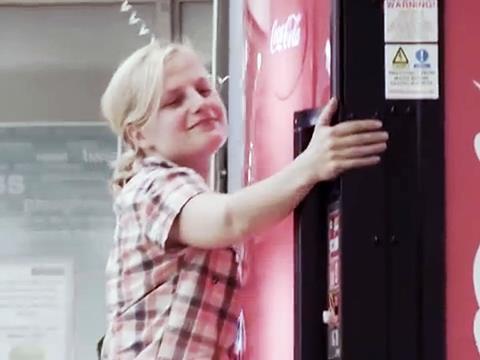
Biggest spender: Coca-Cola
Although it only upped Y-o-Y spend by 0.4%, Coca-Cola’s budget swelled to £18,873,723 in 2013. Its biggest promotion was ‘Share a Coke’ which utilises the brand’s long-standing ‘open happiness’ mantra with heavyweight support across print, outdoor and TV. Most executions focused on individual consumers telling their stories of who they would share a Coke with, although ambassadors such as boxer Anthony Ogogo also featured.
Biggest increase: Special K
Special K’s ad expenditure increased by 50% in 2013 to £14,557,748, due to the brand’s consistent use of TV throughout the year. In keeping with previous campaigns, this execution attempts to help consumers regain confidence in their natural beauty with vibrant, upbeat creative and the emotionally uplifting tagline ‘what will you gain when you lose?’. Online support also continues to form a strong element of the brand’s activity.
Biggest % rise: Ambi Pur
Procter & Gamble’s Ambi Pur brand saw the largest increase in advertising spend, rising by 2,364%. With a significantly larger frequency and variety of TV executions running in 2013 this ad represented an interesting partnership with sister product Febreze, to drive sales across the wider portfolio. However, spending on Febreze fell by 39%, the highest amount across the top 20 fmcg brands.
Many brands ‘legitimately’ buy likes by paying Facebook to promote its page and push it into the newsfeeds of people it thinks will like it, but Muller says click farms also like thousands of legitimate ads to cover their tracks - and that is where the problem lies. Thousands of fake likes can actually harm a page, because Facebook works by monitoring engagement with a page, for example comments or content sharing, to decide if it’s popular. If there is a lot of engagement, which you would see from people that genuinely like the page, the Facebook algorithm spreads it around, generating more exposure. However, if the people that liked the page never engage with it, Muller says the page goes backwards.
To demonstrate his theory, Muller took Facebook up on an offer to promote his Veritasium page and quickly received an impressive 80,000 likes. However, 75% of those likes came from developing countries and accounted for just 1% of his engagement, making them “worse than useless” because they stymied his page.
Worse still, Muller alleges the flawed system means Facebook makes money twice. First by charging the page to acquire fake likes, then, because those fake likes restrict the progress of the page, the only option is for them to pay Facebook again to promote its posts.
The industry is “buzzing” with reports of mystery likes on “legitimate and well-known” brand pages that have “worrying” consequences for those affected, says John Barton, MD and co-founder of Testify Digital.
“First, you are paying for meaningless clicks per like. Second, the overall engagement quality of your audience depletes the greater percentage of fake ‘likes’ you have, which means you will have to pay more to boost your post reach. Third, Facebook has no facility to allow you to identify and delete fake ‘likes’ en masse.”
Ultimately, as Barton says, Facebook is “neither formally acknowledging the problem nor offering a solution, so your Facebook activity is going to become less effective and more expensive as your ‘like fraud’ problem escalates.”
Facebook itself sees the ‘fake likes’ issue differently and, in fairness, it has plenty of impressive statistics from some of the world’s biggest brands to back it up.
“Fake likes don’t help anyone,” says head of CPG at Facebook, Erin Hunter. “Coca-Cola has recently had great success launching a multichannel campaign that delivered a 2.74x return on investment on Facebook. Cadbury saw results that rivalled TV for efficiency, reaching 15 million people and a 4x uplift in purchase intent through Facebook plus TV, versus TV alone. They also saw an 18% increase in brand consideration, which is equal to TV, yet at a third of the cost. Those kinds of real-world results would not be possible with fake likes. And we are continually improving the systems we have to monitor and remove them from the system.”
Likes aren’t necessarily the most important metric for brands to follow anyway, she adds. “Traditional marketing objectives like reach, awareness, sales and share” all work “incredibly well on a platform rich in data” like Facebook.
“What sets Facebook apart from any other medium is its scale combined with its sophisticated targeting.” As far as targeting is concerned, according to Nielsen in 2013 Facebook offered 89% accuracy for highly targeted campaigns, versus the industry average of 38%.
As for scale, Facebook has “1.2 billion people - not email addresses or account numbers, but real people,” Hunter points out. “This allows for rich targeting on a massive, unprecedented scale, and the value it brings to marketers is far greater than other mediums.”
It’s fighting talk, and although Facebook has had its critics, advertisers are obviously still spending big on it. In the fourth quarter of 2013 Facebook earned £1.41bn in ad sales, up 76% year on year, claims Hunter.
And for all its potential problems, Barton concedes that, for many brands, Facebook is now the “second biggest driver of site traffic next to Google. So it stands to reason that brands can, and should, find a way to engage in that arena.”
A recent survey of more than 2,500 marketing professionals shows they plan to. In the ExactTarget State of Marketing 2014, 57% said they planned to maintain or increase social marketing spending in 2014. Almost half believed social media has become “core” to their campaign strategy. And 95% plan to use Facebook, 93% plan to use Twitter and 82% will use Google.
“The major web properties - Facebook, Twitter and Google - aren’t content to live in above-the-line’s shadow,” says Angus Wood. “Nor should they, given every piece of research we see shows digital’s share of media time on the increase.”
The TV fights back
Traditional media isn’t taking the rise of data-driven social advertising lying down, however - it’s learning from it. And the numbers (see left) show that after three years in decline, spending on TV, print, cinema, radio & outdoor media is back in growth - with the supermarkets spending a record amount.
At the vanguard is Channel 4. “Our data strategy was launched almost three years ago and in that time we’ve drawn in 10 million registered viewers including one in two of all 16 to 24-year-olds in the UK,” says Channel 4 corporate comms manager Victoria Wawman.
TV advertising winners
Who had the ads with the biggest impact in 2013?

Tearjerker: Sainsbury’s Christmas in a Day
A panel of advertising experts assembled by The Grocer to assess the eagerly awaited Christmas campaigns awarded Sainsbury’s a whopping 29/30. The UK agreed. The ad had over 11 million views on YouTube, was tweeted about over 30 million times, including one from Cheryl Cole, and was shared across Facebook over 40 million times. More importantly, Kantar crunched six weeks of Christmas numbers and declared Sainsbury’s the overall winner.
Went viral: Dove Sketches
A simple concept that quickly went viral. A forensic artist sits behind a curtain and draws a portrait based on the subject’s self-description. The artist then draws a second portrait of the same women using only the descriptions of strangers, which turns out to be much nicer. Dove called its Real Beauty Sketches campaign a “compelling social experiment that proves to women something very important: you are more beautiful than you think.”
Big impact: Chipotle Scarecrow
Increased public awareness and distaste of modern factory farming methods inspired this three-minute advert for Chipotle, which championed its use of fresh ingredients. It also promoted an app that educates people about food issues and takes them on a “quest for wholesome, sustainable food.” Visually stunning, and soundtracked by an eerie cover version of ‘Pure Imagination’ by the quirky Fiona Apple, this ad made consumers stop and think.
“We serve them personalised recommendations, exclusive online content and rewards among other things via 4oD. In turn we’re able to glean valuable insight we can use to drive commercial innovations of benefit both to Channel 4 and our advertising partners.”
4oD launched its first demographically targeted ads in 2014 for clients including Unilever and Bulmers, with “really impressive” results, says Wawman, including click-through rates that jumped 109% compared to a non-targeted campaign. Channel 4 is now “looking to introduce further targeting products” to the market.
Sky has also launched AdSmart, which combines the “amazing power of TV advertising with first party data,” according to Jamie West, deputy managing director at Sky Media. “TV is the most powerful brand-building medium, and AdSmart applies the latest data available to it. We have built up a deep and granular understanding of our audiences.”
AdSmart has been in development since 2008, with trials since last summer, and went live in January in six million households. “At any one time there can be up to 200 ads in the Sky box, but in the eco-system we can have over 2,500 adverts,” says West. “There are around 90 different attributes that advertisers can combine to find the best fit for their target market, such as ages of the adults and the kids in the household, whether they are single, couples, men or women.”
Sky has teamed up with Experian as its “primary data partner” and over the coming months it will extend the number of attributes from 90 to over 200 to allow for even more precise targeting, says West. It will also start trialling “flexible targeting, so an advertiser could serve different ads to existing, lapsed or prospective customers.”
Overall, the project has cost Sky “tens of millions” but it has enabled Sky to charge advertisers more. West insists the targeted approach means they are getting better value. “We are charging a premium versus existing, traditional, linear TV. We have to: if we don’t we will cannibalise our existing revenue lines. But because those advertisers are targeting a more specific audience we are making it more cost-effective for them to reach their true audience.”
Like social media, the price for advertising is based on how niche the demographic is that the advertiser wants to target. “There are some advertisers targeting the heaviest TV viewers and we aren’t charging a significant premium for that. Equally there are those that want to target viewers that watch TV relatively rarely and therefore it’s really difficult for us to reach them. The premium varies accordingly.”
So far, the reaction from advertisers has been “really positive. The main aim was to make TV more relevant to brands and, in the launch phase, half of the brands were new to Sky and a third were new to TV.”
The attractions of what Sky is doing are many, adds John Thomson, planning director at media specialists Carat. “AdSmart has brought personalisation to broadcast media. Using it allowed us to change copy depending on who was being targeted. This type of targeting is going to help reduce wastage, ensuring that campaigns become more effective and deliver bigger ROIs.”
It certainly worked for one supermarket. An Ocado case study released by Sky at the AdSmart launch said Ocado combined its existing customer data with Sky’s to target high affluence areas and saw an 8% boost in customers. “This equates to incremental revenues of hundreds of thousands of pounds, from an investment of tens of thousands,” said Ocado.
Big Brother
Perhaps the only drawback of the personalisation trend is that some consumers complain it feels like they are being spied upon. West says he can understand that to a degree, but says AdSmart is simply making advertising more relevant to the person sitting in front of it.
“We need to draw a distinction between AdSmart and online behavioural targeting,” says West. “I don’t like being chased around the internet by behavioural targeted ads but AdSmart is different. It doesn’t take into account your viewing behaviours. We are just showing more relevant ads to your demographic or profile - if you don’t have babies you won’t want to see ads for Pampers.”
A recent trial of targeted advertising by cable channel Comcast in Baltimore saw “channel switching” drop by 32% he says. “To me that means relevant advertising means engaged viewers during ad breaks.”
Advertising turkeys
Which ads went wrong in 2013? Here’s three ads that fell flat, fell foul or fell out
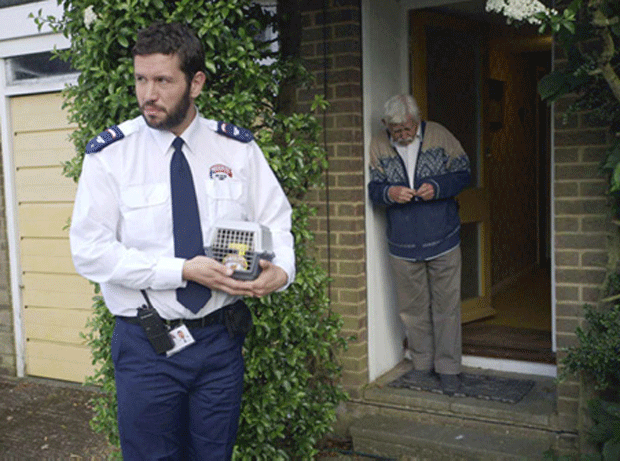
Fell out: Marmite Neglect
Like the spread, many loved Marmite’s End Marmite Neglect ad but many absolutely hated it. The morning after it aired, the ASA was hit with 250 complaints, claiming the ad ‘trivialised’ the work of both animal and child protection charities, such as the RSPCA and NSPCC. “We hope everyone will watch and enjoy this commercial in the light-hearted way it was intended,” said an apologetic Marmite before making a £20k donation to charity.
Fell foul: Peri Peri Pot Noodle
The newfound popularity of Facebook as an advertising channel means it’s not just TV ads that get into trouble. Pot Noodle found its ad for Piri Piri flavour banned by the ASA for being “crass” and “degrading” after it pictured a bikini-clad brunette next to a Pot Noodle asking: ‘Which one gets you hotter?’ A spokesman defended the ads, claiming they made use of the “cheeky” tone commonly used in Pot Noodle advertising.
Fell flat: Asda Snow ‘person’
After the infamous sexism row of 2012, Asda played it safe in 2013, rolling out a row of non-gender specific snowpeople wearing coloured scarves to indicate which supermarket they represented to promote its 10% APG. Too safe, said The Grocer panel of advertising experts that took a look at all the big Christmas campaigns. “After all the fuss around last year’s ‘sexist’ campaign, this might slip by without a whimper,” said one.
Wawman agrees. “Viewers get an enriched experience from Channel 4 as we can serve them personalised recommendations and ads that are relevant to them.”
Whether it’s the basic demographic information currently used by TV, or the relatively complex and comprehensive personal data crunched by social media, if advertisers are “sensitive” there is no need to “unnerve” anyone, says Wood.
“Ultimately, if the feeling you’re generating is uneasiness and intrusion, you’re probably not doing a very good job. It’s about understanding where the human psychology hits up against the new technological possibilities - just because you can do something, that doesn’t mean you should.”
Nonetheless, those new possibilities make targeted advertising at an increasingly granular level a tempting prospect. And Thompson says a fully integrated multichannel campaign based on rich customer data is the future for advertising, so all brands and retailers need to figure out how to get it right - and embrace it.
“In a world where people own multiple devices it is no longer enough to put an advert on TV,” he says. “Brands need to plan across the media eco-system, considering how potential customers make purchasing decisions and then deploying the most appropriate channels to move them towards purchase. And, in this world, data is king.”
Demonstrated by the amount of targeted activity going on, the majority of brands realise that. Even the ones selling a simple cup of tea.
“We measured the impact of our online advertising for Tetley on online sales using ‘Consumer Connect’, which merges retail shopper data with our own user data, and the results showed an incredible 30% uplift in sales and an ROI of £3.75 for every pound spent,” says head of retail at Yahoo Dan Durling. “It shows that a tactical use of data is a very effective way to drive sales, particularly in the food and drink category.”
The number one fmcg brand - and biggest spender - would agree. Coca-Cola says personalisation has become central to its strategy, typified by its decision to let shoppers replace the Coca-Cola logo on bottles with their own names last April. That phenomenally popular campaign was part of Coca-Cola’s response to a “step change in technology and creativity” over the past five years, which has resulted in the creation of a new Coca-Cola advertising “manifesto” based on getting the soft drink closer to its customers in order to advertise to them more effectively.
“Through this understanding we give consumers the opportunity to co-create content aligned with the values and ideals that matter in their everyday lives,” says a Coca-Cola spokeswoman. “As a result of this two-way conversation, consumers are ultimately much more engaged with the brand than through ‘traditional’ advertising.”
So there you have it. In order to ensure its ads resonate with its customers, the number one spender is effectively starting to co-create its ads with them - as well as putting their names on the actual product. Does advertising get any more personal than that?







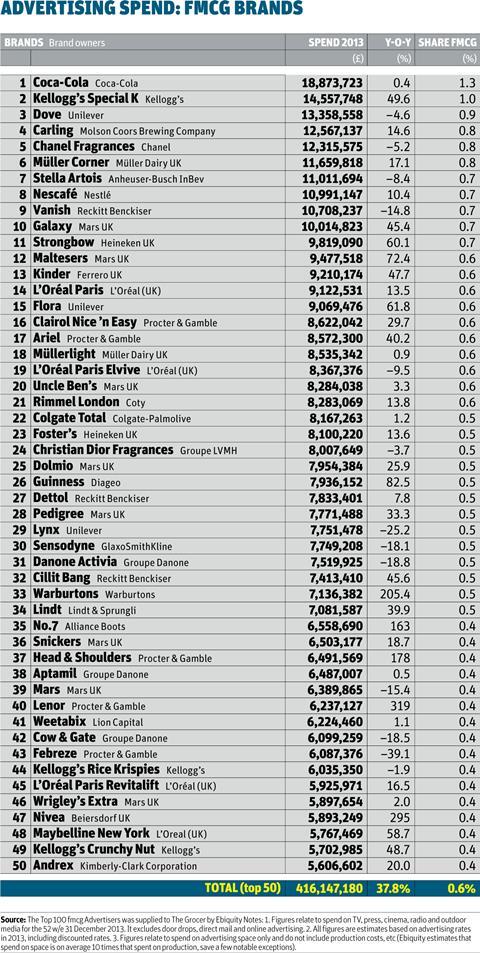

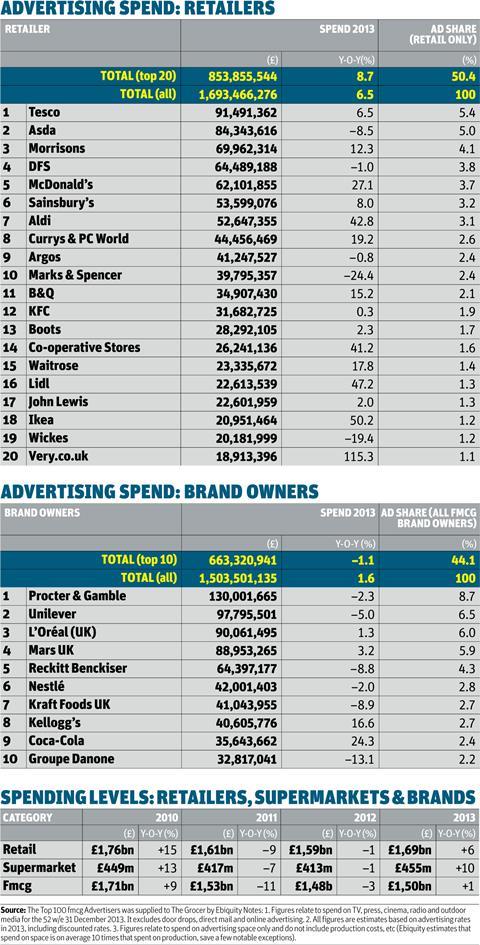


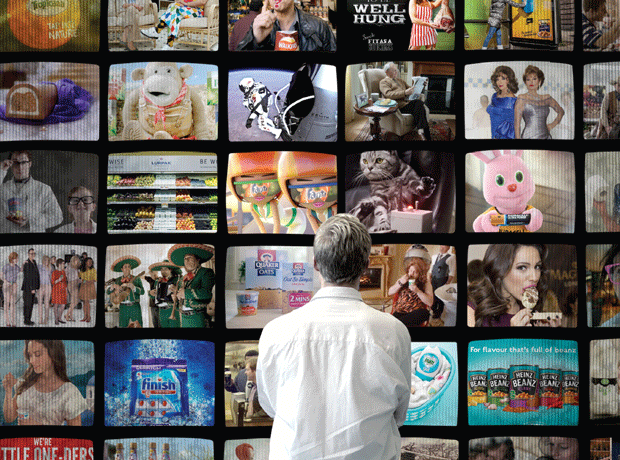
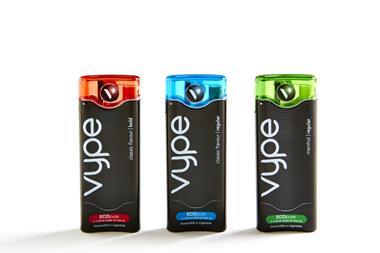








1 Readers' comment